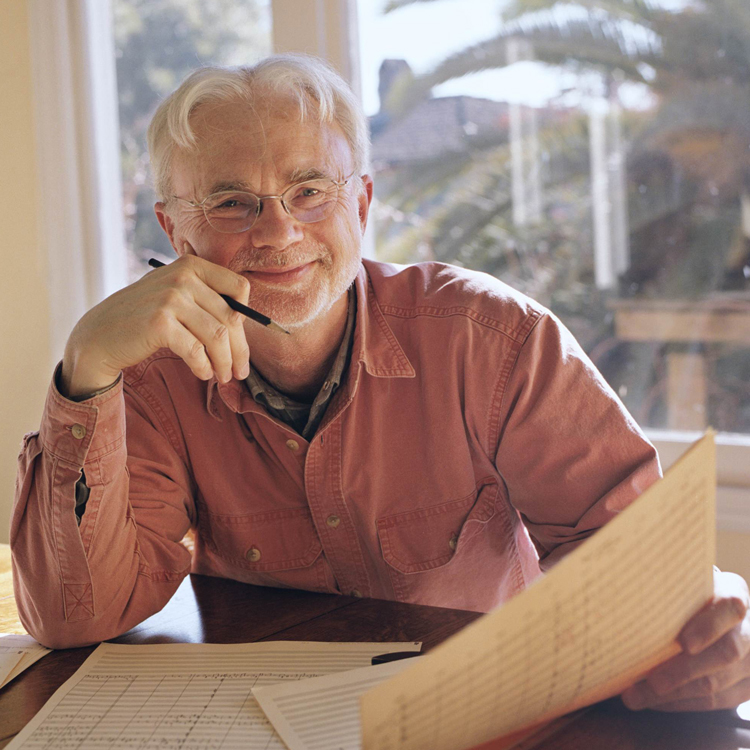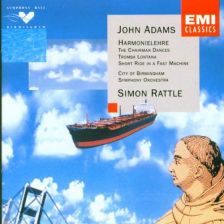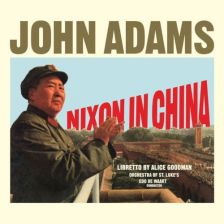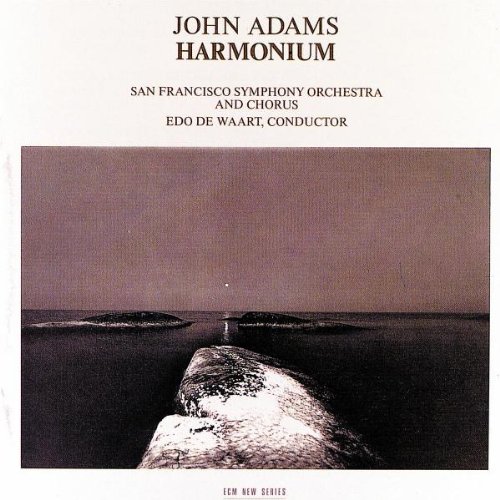Contemporary composer: John Adams
James McCarthy
Friday, February 13, 2015
James McCarthy celebrates that rare beast – a composer who writes music that is enjoyed by the critics and the public alike

There are those who would have you believe that new music is a battleground – a deeply cratered landscape scarred by musical grenades flung by vengeful composers seeking with each new piece to finally silence all of their contemporaries who dare to have a different aesthetic outlook to their own. It’s all ‘-isms’ and ‘schools of composition’ and ‘music’s true path’. And of course it’s utter nonsense and drivel. Don’t believe a word of it.
Enter John Adams (b1947). Having never been a composer who felt the need to conform to anyone else’s idea of the kind of music he should be writing, Adams is consequently one of the most performed composers of concert music today. In 2014 alone, seven of his stage works were performed in venues ranging from the Théâtre du Châtelet in Paris to the Metropolitan Opera in New York. I should like to focus on the music Adams produced from the late 1970s to the late 1980s, the works that established and sealed his reputation as the leading American composer of his generation. This was the period in which what is now regarded as the classic Adams style emerged, with earth-shaking pedal points, glittering woodwind filigree and constant pulsation. The works include the mesmerising solo piano piece Phrygian Gates (1977), the electrifying, twitchy Shaker Loops (1978), the irreverent and beguiling Grand Pianola Music (1982), the epic symphonic fantasy of Harmonium (1980‑81) and Harmonielehre (1984‑85), and the era-defining opera Nixon in China (1985‑87). It remains a staggering period of musical productivity even today. It is rare for a living composer to write anything at all that stands a chance of entering the standard repertoire of orchestras and opera companies; during the 1980s Adams seemed to do it as a matter of course.
It was Harmonium for choir and orchestra that first woke me up to Adams’s music. It featured in Leaving Home, Sir Simon Rattle’s TV survey of music from the 20th century, and I remember as a teenager being so excited by the shimmering textures and intoxicating pulsation of the third movement (a setting of Emily Dickinson’s poem ‘Wild Nights’, which Adams describes as containing a ‘poetic intensity that is at once violent and sexual and full of that longing for forgetfulness which is at the core of all Dickinson’s works’) that I went to my local library to put in a request to borrow a score of the work. What arrived, two weeks later, was not, in fact, Harmonium but the similarly titled but entirely different Adams work Harmonielehre, Adams’s symphony-in-all-but-name which begins with a volley of piledriving chords from the entire orchestra before a seemingly endless melodic line unfurls, bathed in shimmering starlight. So that was that; I was hooked.
The BBC’s new ‘Ten Pieces’ scheme, which aims to introduce primary school children to classical music through 10 specially selected pieces (Handel’s Zadok the Priest, the finale to Stravinsky’s The Firebird, that sort of thing), includes Adams’s exhilarating four-and-a-half-minute fanfare Short Ride in a Fast Machine (1986), which is undeniably an attention-seizing place to start exploring Adams’s music. Personally, however, I would advise beginning with the third movement of Harmonielehre, the fantastically titled ‘Meister Eckhart and Quackie’. Of the typically quirky title, Adams explains: ‘The Zappaesque title refers to a dream I’d had shortly after the birth of our daughter, Emily, who was briefly dubbed “Quackie” during her infancy. In the dream, she rides perched on the shoulder of the medieval mystic, Meister Eckhart, as they hover among the heavenly bodies like figures painted on the high ceilings of old cathedrals. The tender berceuse gradually picks up speed and mass and culminates in a tidal wave of brass and percussion over a pedal point on E flat major.’ There can be few more overwhelming musical climaxes than that which builds into a flooding torrent of sound at the end of this movement. When performed with real passion in a concert hall the experience is literally breathtaking. There are a handful of very good recordings but Rattle’s exquisitely detailed account with the CBSO would be my first choice.
Like many young composers starting out, Adams found regular income in academia and taught music at the San Francisco Conservatory from 1972 to 1982. It was while at the Conservatory that Adams composed what he considers his true ‘Opus 1’, Phrygian Gates. In this 22-minute work for solo piano, the idea that would fuel all of his works in the following decade crystallised. He describes the process thus: ‘With harmonic rhythm (ie the rate of changes between harmonies) radically slowed down, modulation took on a new and exciting meaning and I found that, when properly handled, it could accomplish the effect of a kind of celestial gear shifting.’ The process is essentially a kind of musical delayed gratification. Think of Ravel’s Boléro. Philip Clark (in his Gramophone ‘Collection’ article on Ravel’s masterpiece in the Awards 2010 issue) wrote, ‘after cruising in C major for 15 minutes, Ravel slips the harmonic gearstick up into E, causing a jolt that refuels his narrative and readies listeners for that crash-land climax. Ravel teases the senses. His nuances of orchestration and harmony only taste as pungent as they do because there’s nothing else to listen to.’ The same process is at work in all of these early Adams scores. Part of the reason that Adams is capable of such extreme harmonic stretching is because, like Ravel, he is a master orchestrator, a true craftsman.
In the mid-1980s, when the maverick director Peter Sellars suggested that he should write an opera about President Nixon’s visit to China in 1972, Adams was initially cool on the idea. It was only when Alice Goodman agreed to write a libretto in couplets that Adams started to take the project seriously. Nixon in China was Adams’s first stage work, and he readily concedes that he isn’t an opera-goer, yet it has become one of the most widely performed new operas of the last 40 years – it could even claim be the most-performed American opera of all, but don’t quote me on that. There are several standout moments in Nixon; but to get an immediate feel for the work, zoom in to the arias ‘News has a kind of mystery’ (Act 1 scene 1), ‘This is prophetic’ (the repeated words ‘Bless this union with all its might / Let it remain inviolate’ at the end of this aria – particularly as performed by Carolann Page as Pat Nixon in the original recording conducted by Edo de Waart – are chilling in the extreme; Act 2 scene 1) and the grandstanding, buccaneering ‘I am the wife of Mao Tse‑tung’ (Act 2 scene 2).
By restricting my focus only on the music that Adams composed from his mid-thirties to his mid-forties I have left a great many superb works untouched. For instance, the Violin Concerto from 1993, which won the world’s biggest prize for composition, the Grawemeyer Award (try Chloë Hanslip’s account on Naxos, which Philip Clark labeled ‘the sort of performance that secures a reputation for life’), or The Gospel According to the Other Mary from 2012, the premiere recording of which (conducted by Gustavo Dudamel on DG) was shortlisted for a Gramophone Award last year. The music that Adams has composed since 1990 is generally more rhythmically and harmonically volatile, as if he is kicking against the widely imitated style of those popular early works.
Adams is a restlessly inventive composer, one who builds the language and form of every new piece from scratch rather than relying on gestures or harmonic and melodic ‘moves’ that have worked well in the past. In his memoir, Hallelujah Junction, Adams writes about the painful nature of his creative process: ‘On a dark day I will become nearly overwhelmed at how little I have mastered in my life. Starting a new piece can cause me torment and can mean having to slog through a dismal swamp of indifferent ideas, pushing them, prodding them, often abandoning them in disgust or desperation.’ Let this be a reassurance to any composers reading this who are in the early stages of creating a new work. You are most definitely not alone in your struggles. Keep going.
So there we have it – an entire article about John Adams’s early music without a single mention of post-minimalism…oh, blast.
Three essential Adams recordings

Harmonielehre
CBSO / Sir Simon Rattle
(EMI/Warner Classics)
'Rattle’s account of Harmonielehre brims with fascinating details and the climax at the end of the third movement will have you jumping out of your seat.' Gramophone review

Nixon in China
Sols; Chorus and Orchestra of St Luke’s / Edo de Waart
(Nonesuch)
'This is the cast that premiered Nixon with Houston Grand Opera: James Maddalena as Richard Nixon, Sanford Sylvan as Chou En-lai and the sensational Carolann Page as Pat Nixon. A cheaper alternative is offered by Marin Alsop on Naxos but it doesn’t quite have the same electric atmosphere as the original recording.' Gramophone review

Harmonium
San Francisco Symphony Orchestra / Edo de Waart
(ECM New Series)
'Harmonium was Adams’s first big orchestral commission (from the San Francisco Symphony) and the first time he had written for choir. Which makes the intoxicating power and authority of the composition all the more astonishing.'
This article originally appeared in the January 2015 issue of Gramophone.











